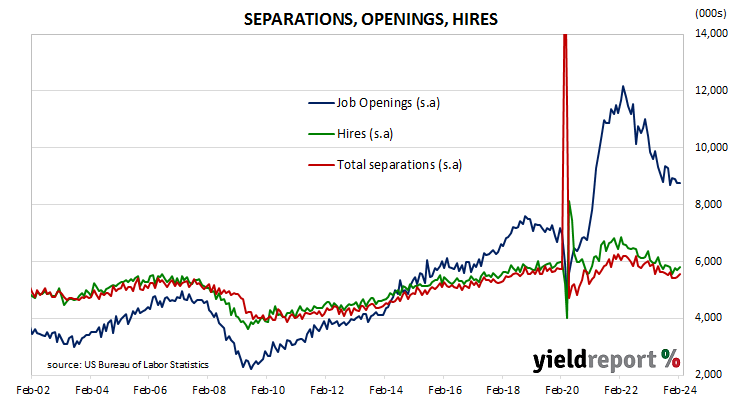Summary: US quit rate steady at 2.2% in February; short-term US Treasury yields slip, longer-term yields up; expectations of Fed rate cuts firm; ANZ: ratio of job openings to available workers points to moderation in labour-market-driven inflation pressures; more quits, openings, separations.
The number of US employees who quit their jobs as a percentage of total employment increased slowly but steadily after the GFC. It peaked in March 2019 and then tracked sideways until virus containment measures were introduced in March 2020. The quit rate then plummeted as alternative employment opportunities rapidly dried up. Following the easing of US pandemic restrictions, it proceeded to recover back to its pre-pandemic rate in the third quarter of 2020 and trended higher through 2021 before easing through 2022 and 2023.
Figures released as part of the latest Job Openings and Labor Turnover Survey (JOLTS) report show the quit rate remained steady in February. 2.2% of the non-farm workforce left their jobs voluntarily, unchanged from January. Quits in the month increased by 38,000 while an additional 229,000 people were employed in non-farm sectors.
Short-term US Treasury yields slipped a little while longer-term yields rose. By the close of business, the 2-year Treasury bond yield had lost 1bp to 4.70%, the 10-year yield had gained 5bps to 4.36% while the 30-year yield finished 4bps higher at 4.50%.
In terms of US Fed policy, expectations of a lower federal funds rate in the next 12 months firmed, with several cuts already factored in. At the close of business, contracts implied the effective federal funds rate would average 5.31% in May, 2bps below the current spot rate, 5.22% in June and 5.16% in July. March 2025 contracts implied 4.48%, 85bps less than the current rate.
“However, owing to the rise in US unemployment in February, the ratio of job openings to available workers eased to 1.36 versus 1.42, pointing to a supply driven rebalancing and moderating in labour market driven inflation pressures,” said ANZ senior economist Blair Chapman. “The data helped settle the selloff in the bond market.”
The rise in total quits was led by 77,000 more resignations in the “Retail trade” sector while the “Accommodation and food services” sector experienced the largest decline, falling by 53,000. Overall, the total number of quits for the month increased from January’s revised figure of 3.446 million to 3.484 million.
Total vacancies at the end of February increased by 8,000, or 0.1%, from January’s revised figure of 8.748 million to 8.756 million. The increase was driven by a 126,000 gain in the “Finance and insurance” sector while the “Information” sector experienced the single largest decrease, falling by 85,000. Overall, 9 out of 18 sectors experienced more job openings than in the previous month.
Total separations increased by 110,000, or 2.0%, from January’s revised figure of 5.449 million to 5.559 million. The rise was led by the “Retail trade” sector where there were 108,000 more separations. Separations increased in 10 of the 18 sectors.

The “quit” rate time series produced by the JOLTS report is a leading indicator of US hourly pay. As wages account for around 55% of a product’s or service’s price in the US, wage inflation and overall inflation rates tend to be closely related. Former Federal Reserve chief and current Treasury Secretary Janet Yellen was known to pay close attention to it.


